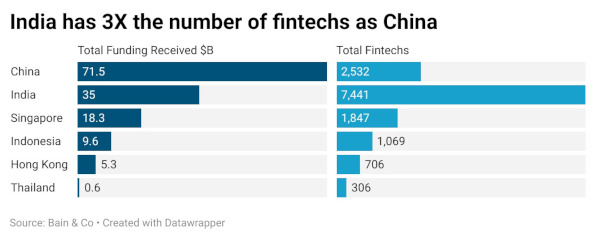[A high-growth environment like India’s attracts various types of businesses, sometimes leading to chaotic situations. This often clashes with the regulation, which often errs on the side of caution. Image from Unsplash]
The goals of regulators (stability and safety) and startups (innovation and scale) don’t always align
The rapid growth of fintech companies over the past decade has highlighted the inherent conflict between the fintech players and regulators. Fintechs are laser-focused on innovation and rapid scaling, while regulators are solely concerned about financial stability and consumer protection.
Fintechs have a tendency to “move fast and break things”—iterate quickly, get products into the hands of users, and worry about perfecting things later. Startup founders often work with an “unreasonable sense of urgency”, as Basecamp founder David Heinemeier Hansson puts it. There are problems to solve, funds to raise and markets to capture. It’s a high-growth environment. And such environments attract various types of businesses, sometimes leading to chaotic situations.
Sanjay Swamy, a partner at Prime Venture, likens it to teenagers. “The industry is in its teenage years. Some companies will suddenly shoot up, some will struggle, some will grow, some will face challenges. There will be some good, some bad, and some terrible things happening. Not all things can be predicted.”
This often clashes with the more cautious and deliberate pace of regulation. Regulators often err on the side of caution.
This has two problems. One, it could stifle innovation. That would be unfair to those who are not currently served—or are underserved in terms of cost and convenience—by the existing players. Two, some of the regulations tend to be sweeping, hitting not only the black sheep but also the more responsible startups.
The challenge is in encouraging innovation, even while avoiding the harm the new products or processes might bring.
The US, Europe and China have all taken different approaches to strike a balance between the two
Policymakers and regulators across the world purport to achieve this balance, but follow different approaches. The US primarily follows a principles-based approach, which gives fintech companies more flexibility in how they comply with the law, but it also means that they have more responsibility to understand the law and to act in a responsible manner. If consumers are harmed, they typically seek justice in court. For example, when users found that the Plaid app collected and shared their data, it resulted in a class action suit, which the company settled by paying over $58 million in 2022.
Europe primarily follows a rules-based approach, issuing specific regulations that apply to the sector. These regulations provide more clarity for fintech companies. The EU's General Data Protection Regulation (GDPR) gives consumers more control over their personal data. Payment Services Directive 2 (PSD2) requires banks to share customer data with third-party providers, which has led to the development of new fintech products and services, such as the integration of payment apps and wallets with online shopping platforms. Even so, some businesses, justifiably, complain that these rules make it harder to innovate. “While the EU is the model for other countries, it is also a cautionary tale of the unintended consequences of applying broad regulatory fixes to a rapidly evolving landscape,” two professors from the University of Florida wrote in 2021.
China has taken a more experimental approach to regulating fintech, allowing the sector to grow rapidly, but making it clear that the government could come down heavily on it at any time. Sanjay Jain, partner, Bharat Innovation Fund, recalls an interaction between entrepreneurs and a regulator in China years ago during the peer-to-peer (p2p) lending craze in the country. “On stage, a central bank official said, ‘Last week, we organised a trip for many of our p2p lenders. We made them visit the local jail and told them, ‘You know, if you do something wrong, you'll end up in a different world here.’” Later, China indeed cracked down on many of these players, and the tech industry in general with a heavy hand. It cancelled the IPO of Ant Group, one of China’s most well-known fintech firms, citing regulatory reasons.

India is forging a different approach
While policymakers in many countries tend to talk about balancing innovation and safety/stability, in India, they almost always include inclusion as one of the goals. Many key government initiatives such as NREGA, RTE, and Aadhaar got political support because they helped achieve inclusion. This has informed fintech regulations too, even as the regulators pursued the primary objectives of financial stability, consumer protection and integrity of the financial system.
Three broad principles have marked the approach of Indian regulators: building expertise; making adaptive, risk-based interventions; willingness to use a range of tools.
Indian regulators have steadily built expertise in fintech
A few years ago, whenever fintech founders met, it was customary for them to rant about how regulators simply “don’t get tech”. In 2019, a Baker McKenzie survey, covering 600 executives in Asia-Pacific, including 100 in India, found that 70% of executives believe regulators struggle to keep pace with technological change. That’s not true, at least as far as RBI goes, says a tech veteran who has been interacting with the central bank for at least a decade.
The reports published by inter-regulatory groups, the feedback process, the speeches and the conversations regulators have with the industry in various forums indicate nuanced thinking about fintech. The RBI has its own fintech division. It has an innovation hub, whose directors include Kris Gopalakrishnan, a co-founder and former CEO of Infosys, and Prof Ashok Jhunjhunwala, an enterprising professor from IIT Madras, among others.
Yet, it’s easy to see why fintech players feel frustrated. Indian regulators rarely face public scrutiny like their American counterparts do in Senate hearings, says Mandar Kagade of Black Dot Public Policy Advisors. Press conferences are often dominated by other immediate issues. The circulars, the most visible signs of their expertise, don't reveal their full thinking even when it has far-reaching consequences, like the two-paragraph circular by the Reserve Bank on prepaid instruments last year. At one point there was a new circular every fifteen days.
Indian regulators tend to use an adaptive and risk-based approach to intervention
This tendency to constantly tweak the regulations comes from responding to feedback from the system.
“In India, regulators get involved when activity reaches a certain size and regulate the industry before consumer harm happens. If they see practices that are heading in that direction, they will put a stop to it sooner rather than wait for the harm to happen,” says Jain of Bharat Innovation Fund.
A case in point is how India dealt with Chinese lending apps. In China, digital lending apps emerged in the 2010s as an alternative to banks, providing credit access to underserved individuals and small businesses. As platforms proliferated, many lacked risk controls, leading to defaults and unethical collection practices, sparking public outrage. In response, China's government cracked down, introducing rules requiring platforms to register as financial institutions and imposing stricter regulations. Thousands of non-compliant platforms were shut down. The regulatory overhaul led to major industry consolidation, with only a few platforms surviving.
A few years later, when India was all excited about fintech, the market was flooded with Chinese apps that followed the same playbook as they had in China. There were reports of predatory practices, a lack of transparency, and a big pool of distraught customers. The Indian government responded by banning those apps in one go.
It has also relaxed regulations. For example, after dealing a blow to digital lenders last year by barring FLDGs, or first loan default guarantees, it relaxed the norms allowing fintechs to guarantee up to 5% of loans.
Regulators have used multiple tools to balance innovation and regulation
RBI has thrown its weight behind some technologies which have aided innovation. For example, when UPI was launched in 2016, some media outlets attributed it to then RBI governor Raghuram Rajan (Economic Times: Raghuram Rajan gives a parting gift. Business Line: A brainchild of RBI Governor Raghuram Rajan.) Similarly, Account Aggregator was launched with the blessings and support of four financial regulators: RBI, IRDA, PFRDA and SEBI.
The RBI launched Regulatory Sandbox, which allows live testing of new products in a controlled regulatory environment to generate evidence on the benefits and risks of financial innovations.
For fintechs, this means more focus on self-regulation and building better products
For fintech, it means a number of things. One, they cannot wish away regulation, because banking and finance are regulated industries, and will remain so. Recently, at an event organised by Sahamati in Mumbai, a moderator asked R Gandhi, a former deputy governor of RBI, what his advice was to entrepreneurs assembled in the hall. Gandhi replied, “Never forget, there is a regulator watching you.”
Two, industry players should work harder on self-regulation. In the case of digital lending, some self-regulation could have stopped RBI from coming down heavily on non-regulated entities. “When the Chinese apps were banned, the digital lending apps could have learned a lesson, but they became the new ‘cowboys’,” says an industry veteran.
There have also been positive examples. In the early days of UPI, the regulator (RBI) decided that the KYC (Know Your Customer) of merchants would be done by their sponsor banks. However, sponsor banks had much more rigid KYC requirements than fintech companies, which led to complaints from the fintech industry. The fintech industry eventually made a representation to RBI asking for the KYC process to be delegated to them. RBI took some time to consider the request, but eventually agreed to the change. The industry followed the rules until the change was implemented, and everything worked out in the end.
“Successful fintech founders realise they are in it for the long haul, not quick wins. Building sustainable fintech businesses takes time, even decades. It's a marathon, not a sprint. There is a growing recognition among some founders that they need to build with a long-term, stable, compliant approach. They need to be patient, take a mature perspective, and allow their businesses adequate time to reach their potential”, says Deepak Sharma of Kotak Mahindra Bank.
And finally, innovation and regulations need not be at loggerheads. For example, the digital KYC process was an improvement over the traditional paper-driven process where it’s hard to keep a tab on where photocopied documents go, how many copies are made or how they are used. Similarly, the account aggregator framework allows the safe and secure transfer of data. That could happen to digital lending too. As access to data improves, lenders could move to loan products that give them visibility of the end use of loans, as well as have the repayment linked to a cash flow. It’s like a loan a business gives to an employee to buy, for example, a car. It has visibility of the end use of the loan, and has control over the cash flow (as it deducts the EMIs from the salary).
It provides transparency on how the funds are being used. Locking repayment to cash flow also ensures affordability and aligns incentives for the lender and borrower. This type of lending maximises the chance loans can be repaid on time. It minimises the risk of over-indebtedness. But it won’t happen by itself. “Fintech players should focus on building better products,” says Sharad Sharma, co-founder, iSpirt, a voluntary organisation based in Bangalore.
That would mean turning their attention away from growth hacking to building products that serve customer needs and not just serve their VC partner’s hunger for growth.
“When fintechs raise more funds, the first thing they do is invest more in marketing. When we speak to them they say onboarding, marketing, and reaching new customers are their biggest expenses. But they should focus spending on product design, building better products,” Dvara Research’s Beni Chug says.
(This Special Report was supported by the Mumbai Press Club – N R Prakash Fellowship for Science & Technology 2022)
Read all 4 parts here.

